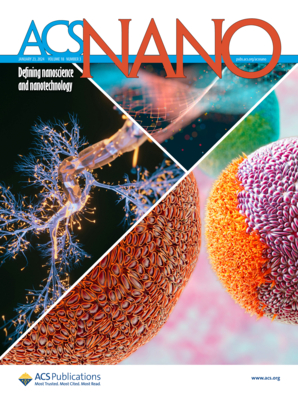Molecular Stacking@Infinite Coordination Polymer Nanocomposites for Tumor Continuous High-Intensity Photothermal-Thermodynamic Alternate Cycle Therapy and Chemotherapy.
IF 16
1区 材料科学
Q1 CHEMISTRY, MULTIDISCIPLINARY
引用次数: 0
Abstract
To enhance synergistic therapeutic efficiency of tumor photothermal-thermodynamic-chemotherapy and address challenges of limited laser penetration, uneven heating, and poor temporal coordination among therapeutic modalities, we fabricated a photomicroneedle (PMN) system consisting of an optical fiber integrated into a perforated stainless-steel microneedle, in which the laser delivered via the PMN is emitted both from the tip and the sidewalls, enabling uniform intratumoral irradiation. The PMN-assisted tumor continuous high-intensity photothermal-thermodynamic alternate cycle therapy and chemotherapy strategy that consistently keeps over 90% tumor cell death within 48 h was developed. To implement this strategy, dual-layer nanocomposites were engineered by self-assembling IR825 and doxorubicin (DOX) into core nanoparticles (Dp825 NPs), which were then encapsulated in polydopamine (PDA)-Fe(III)-folic acid (FA) infinite coordination polymer (ICP) shell loaded with artesunate (ARS), forming nanocomposites (Dp825:ARS@PDA-Fe(III)-FA ICP NCPs). The resulting nanocomposites have high drug loading and tumor targeting efficiency, enabling precise spatiotemporal control of drug release to meet the requirements of the above coordinated strategy. In vivo studies demonstrated complete eradication of large tumors (∼300 mm3) without recurrence over 60 days, using only 300 mW·cm-2 laser power and a total injection dose of 5.0 mg·kg-1, which offers a promising platform for highly effective and minimally side-effect tumor therapy.分子Stacking@Infinite配位聚合物纳米复合材料用于肿瘤连续高强度光热-热力学交替循环治疗和化疗。
为了提高肿瘤光热-热力学-化疗的协同治疗效率,并解决激光穿透有限、加热不均匀和治疗方式间时间协调性差的挑战,我们制造了一种显微针(PMN)系统,该系统由光纤集成到穿孔不锈钢微针中,其中通过PMN传递的激光同时从尖端和侧壁发射,实现均匀的肿瘤内照射。研究了pmn辅助肿瘤连续高强度光热-热力学交替循环治疗和化疗策略,可使90%以上的肿瘤细胞在48 h内持续死亡。为了实现这一策略,通过将IR825和阿霉素(DOX)自组装成核心纳米粒子(Dp825 NPs)来设计双层纳米复合材料,然后将其封装在装载有青蒿琥酯(ARS)的聚多巴胺(PDA)-铁(III)-叶酸(FA)无限配位聚合物(ICP)外壳中,形成纳米复合材料(Dp825:ARS@PDA-Fe(III)-FA ICP NPs)。所制备的纳米复合材料具有较高的载药量和肿瘤靶向效率,能够对药物释放进行精确的时空控制,满足上述协同策略的要求。体内研究表明,仅使用300 mW·cm-2的激光功率和5.0 mg·kg-1的总注射剂量,就可以在60天内完全根除大肿瘤(~ 300 mm3)而不会复发,这为高效和最小副作用的肿瘤治疗提供了一个有希望的平台。
本文章由计算机程序翻译,如有差异,请以英文原文为准。
求助全文
约1分钟内获得全文
求助全文
来源期刊

ACS Nano
工程技术-材料科学:综合
CiteScore
26.00
自引率
4.10%
发文量
1627
审稿时长
1.7 months
期刊介绍:
ACS Nano, published monthly, serves as an international forum for comprehensive articles on nanoscience and nanotechnology research at the intersections of chemistry, biology, materials science, physics, and engineering. The journal fosters communication among scientists in these communities, facilitating collaboration, new research opportunities, and advancements through discoveries. ACS Nano covers synthesis, assembly, characterization, theory, and simulation of nanostructures, nanobiotechnology, nanofabrication, methods and tools for nanoscience and nanotechnology, and self- and directed-assembly. Alongside original research articles, it offers thorough reviews, perspectives on cutting-edge research, and discussions envisioning the future of nanoscience and nanotechnology.
 求助内容:
求助内容: 应助结果提醒方式:
应助结果提醒方式:


